Video: Planting Fall Crops for Harvest with Garden Answer
Fall crops already? That’s right! Join Garden Answer and get some great ideas for food crops in the upcoming season.
Featured Products
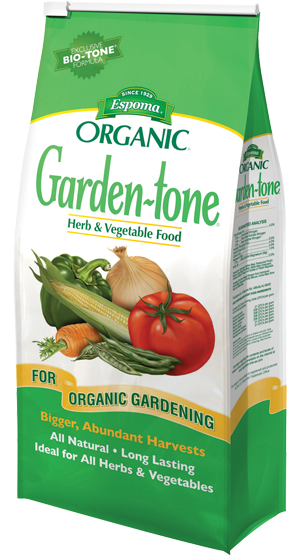
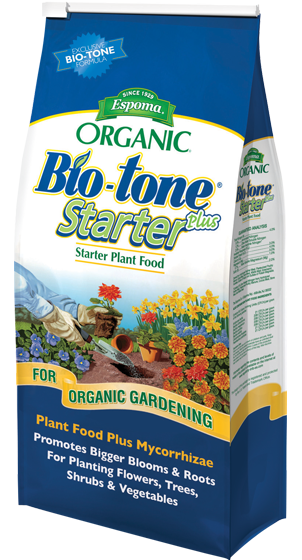
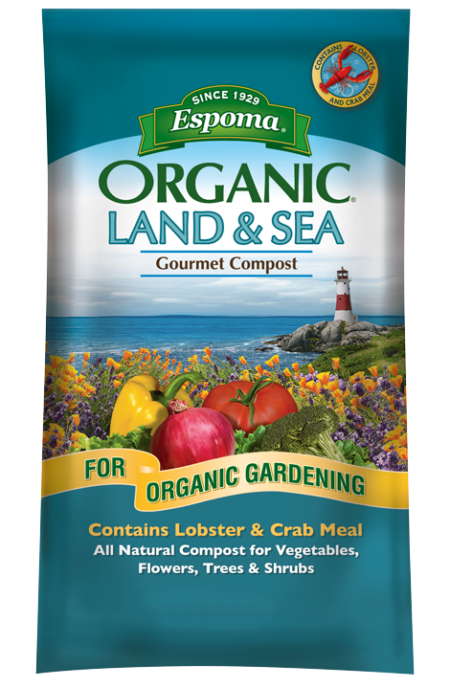
Fall crops already? That’s right! Join Garden Answer and get some great ideas for food crops in the upcoming season.
Featured Products



English cottage gardens date back centuries. They were used to grow vegetables, herbs for healing, fruit trees, perhaps a beehive, and common flowers. The informal style went through a renaissance in the late 1800’s when they became somewhat more nostalgic than practical.
The informal aesthetic of dense planting and natural materials is still en vogue today. In this video, Laura outlines 10 design principles to help you design a cottage garden. Before you start, make sure you have plenty of Espoma’s organic Bio-tone Starter Plus plant food to make sure your plants get the best possible start.
No Straight Lines
Cottage gardens are always informal and a touch whimsical. Avoid straight lines. Gently curving edging looks more natural and playful. If your site restricts you to a straight edge, let the plants spill over it to create an unrestrained look.
Large Groups of the Same Plant
White cottage gardens are more relaxed in their design, it is still best to use large sweeps of the same plant. Think of planting in groups of three, five or seven. That is far more restful to the eye than a jumble of onsies and twosies.
Spacing Doesn’t Matter
This is one time you do not have to follow the advice on the plant tag. Cottage gardens are always densely planted and generally grow more densely packed with time. Annuals and biennials are often used in cottage gardens and will self-sow in the border. Biennials are plants that take two years to grow and flower from seed like the foxgloves shown. Another advantage to planting things close together is that there is less room for weeds to grow.
Color Harmony
It’s very important to pick a collection of plants that have harmonious colors. Without that the border would look chaotic. Garden Answer uses a collection of soft pinks and peaches with touches of blue and lavender. It needn’t always be soft colors, but they do need to be unified in some way.
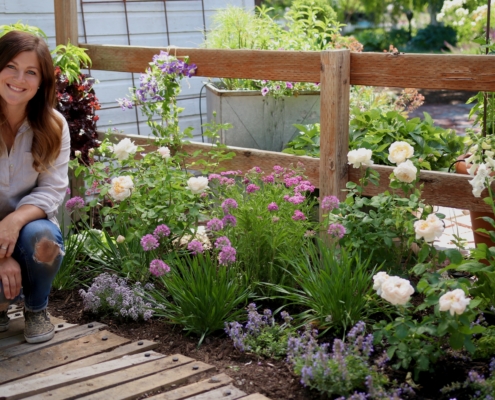
Use Varied Heights and Textures
In any planting, it’s a good idea to think about texture, height and foliage color as major design elements. Nothing blooms all the time. Varied foliage forms and colors will create interest even when the flowers aren’t in bloom. Laura uses Heuchera specifically for the silvery foliage color.
Anchor Plants/Structural Elements
This is sometimes referred to as the “bones” of a garden. It’s a structural element that all of the other plants get woven around. In this case, it’s a beautiful shrub rose named Rose ‘The Lady Gardener’, a fragrant beauty with full, apricot blossoms. The rose is repeated three times. Repetition is soothing to the eye. It’s possible to use evergreens for a slightly more formal feel, or whatever peaks your interest.
Fragrance
The first thing everyone does when they pick a flower is to hold it up to their nose. Cottage gardens are known for their fragrance. Try to select varieties that smell good at the garden center. Roses, lavender, sweet peas, and sweet alyssum are all good choices.
Not Perfectly Maintained
Along with relaxed design principles, comes relaxed maintenance. Planting tightly will discourage weeds. Annuals like poppies will self-seed and move around the border, just like the biennial foxgloves. Weeding everything that comes up might mean that you weed out these plants and inhibit their spontaneous movements.
The Look Will Change Over Time
This style of gardening is the exact opposite of a formal border filled with geometric shaped boxwood. By its very nature this is meant to be more random. People often sow cosmos, violas and other plants that have a tendency to move around. Let them surprise you. If you really don’t like where one popped up, it’s easy enough to remove.
Be Patient
Being patient is really what gardening is all about. A garden is never really finished. Enjoy the journey!
Garden Answers Plant List
Nepeta ‘Cat’s Pajamas’ – catmint
Achillea – pink yarrow
Allium ‘Serendipity’ – ornamental onion
Rose ‘The Lady Gardener’
Heuchera Dolce ‘Spearmint’ – Coral Bells
Clematis ‘Brother Stephan’
Digitalis Foxy Hybrids – foxglove
Lobularia ‘Blushing Princess’ – sweet alyssum
Here are more videos from Garden Answer we hope you will enjoy.
How to Plant Cottage-Style Flower Beds!
Plant Your Window Boxes Like Garden Answer
Succulent Pot in a Pot – Quick Version
How to Re-pot Houseplants – Quick Cut
*****
Featured Products:
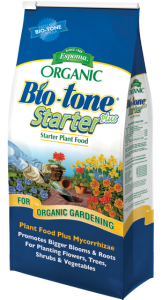
Separating large aloe plants into several smaller ones is a wonderful way to propagate new plants to share with friends and family or to use in other projects. It’s also a great way to save money. The large Gold Tooth Aloe Laura from Garden Answer divides in this video cost $22 and produced over 20 new plants.
Aloes are desert plants that are hardy in zones 9-11, or to about 20 degrees Fahrenheit. In cooler regions they may be grown in containers and brought indoors for the winter. Aloe is a clump-forming plant meaning they naturally produce many baby plants called offsets. Mature plants flower in late spring and early summer with bright orange-red blossoms that attract pollinators.
Six Steps to Separating the Offsets
Replanting the Mother Plant
It is always best to use fresh soil when repotting since the nutrients in the nursery potting soil are likely used up. All succulents and cacti need a free-draining, organic, potting soil like Espoma’s Cactus Mix. Roots will rot in wet soil. The main plant will still have plenty of roots and can be repotted. Wait to water it for about a week to allow the leaf scars to callous over. This helps to prevent disease and infections.
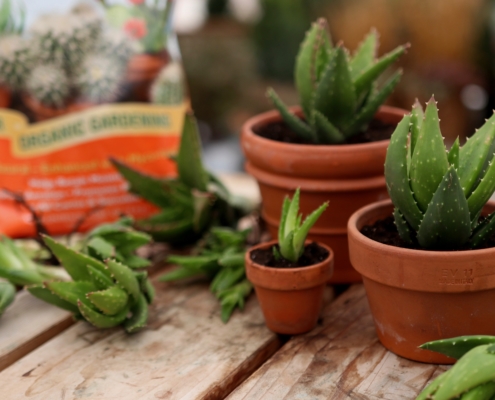
Photo courtesy of Garden Answer
Replanting the Offsets
The offsets all have open wounds where they were broken off from the main plant. The wounds need several days to dry and callus over. One method involves letting them dry on a table in bright, but indirect sunlight for 5-7 days before planting. They may also be planted right away but not watered in for a week.
Care and Feeding
Aloe prefers full sun to light shade. These plants are drought-resistant but container plants benefit from some extra water during the hottest days of summer. Feed regularly with an organic fertilizer like Espoma’s Cactus! Always follow the package directions.
Check out these blogs for more information about growing succulents and the secrets to their care.
Easy, Breeze Houseplants the Cool Your Home
How to Care For Succulents and Cacti in Winter
Succulent Success – What’s the Secret?
Espoma Products:
Spring has sprung and it’s time to get outside and plant up some early spring containers. A trip to the local garden center will surely inspire you. Plant big pots of brightly colored bulbs and annuals to liven up entryways, patios and balconies. Laura from Garden Answer shows you just how easy it is to do in the video below.
Laura fills her containers with tulips and violas, true harbingers of spring. Alternatively, you could also use daffodils and other cold hardy annuals like Iceland poppies or nemesia. In cold climates, it’s important to select plans that are hardy enough to withstand a cold snap.
These early spring containers will flower for a month or so, bridging the gap from early spring to the frost-free date. When it’s time to plant summer containers, replant the tulips out into the garden where they’ll bloom again next spring. The violas may also be moved to a lightly shaded area of the garden.
Four Easy Steps to Early Spring Containers
Enjoy flowers for even longer by choosing tulips or daffodils that are not yet in full bloom. When finished blooming, just remove the flower stem. The leaves will still provide a vertical accent and the bulbs need the foliage to replenish themselves.
Taking time to deadhead the violas will extend their bloom time. If temperatures are cool, you may only need to water containers once a week.
Check out these videos from Garden Answer about tulips and early spring planting.
Plant Your Window Boxes Like Garden Answer
How to Care For Your Tulips After They’ve Bloomed
Featured Products:
Terrariums are back in style and they’re a fun, easy way to grow and showoff your plants. Terrariums are made of glass and are generally enclose or have a few holes in the cover to provide fresh air. The glass cover traps humidity and recycles it as water, keeping waterings to a minimum. Air holes allow air to circulate and keep the condensation down so that you can see the plants. If your container’s lid doesn’t have air holes, just take the top off from time to time. This is a great way to grow ferns indoors because they need humidity to thrive.
You may not be familiar with hydrostone, a product used for the base layer. It’s a soilless growing media that feels like pumice. It helps deliver the perfect balance of air and water to your plants. It’s a 100 percent recycled product, made in the United States.
Begin by adding a one inch layer of hydrostone in your glass container. Top that with a solid layer of sphagnum moss. This helps hold the soil in place and keeps the stone layer looking clean. Next, add an inch or so of Espoma’s Potting Mix.
Choose your plants. Laura uses maidenhair ferns because they require a high level of humidity, which work perfectly for this type of container. Birds nest ferns and staghorn ferns also work well and look terrific with the curly foliage of the maidenhair ferns. Fern displays are all about texture. Gently remove the plants from their pots and shake off as much soil as you can before nestling them into the new container. Top with a bit more potting soil if necessary.
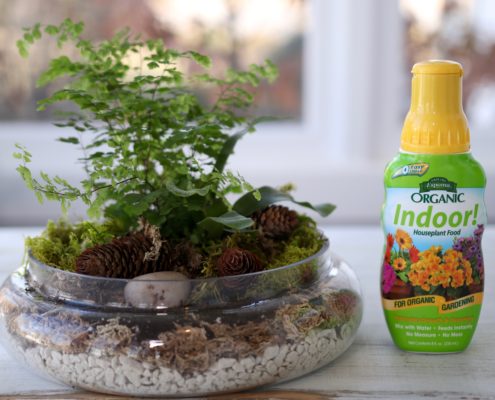
Decorate the top layer with more moss, rocks, miniature fairy garden figures or natural products like pinecones. Whatever you think will look beautiful is the best choice. Leave one little spot of the top soil open. This way you can look at it to gauge how wet or dry the soil is. Mist soil lightly.
At first, it’s a good idea to check your container once a week for watering needs. In general, they’ll only need water about once a month but each terrarium is slightly different. Don’t kill it with kindness, in other words, don’t over water it. Set your new creation in bright light but not direct sun light as the glass can act as a magnifying glass creating too much heat. Fertilize every other month with Espoma’s Indoor! Liquid fertilizer. Now, sit back and enjoy your very chic looking new art project.
Check out Garden Answer’s terrarium video.
Espoma Products for Fern Terrariums!
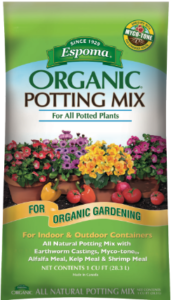
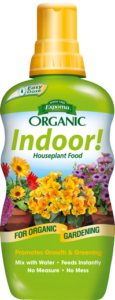
Ferns are classic yet fussy houseplants. Laura @GardenAnswer has all the tips and tricks you need to be successful in growing ferns indoors.
Light Exposure
Contrary to popular belief, ferns need quite a bit of light. Though, they don’t like to be in direct sunlight as their foliage will change to a light yellow color or burn. Keep them near a place that receives plenty of sunshine throughout the day.
Only a few varieties can handle shade and moisture as most people think. Check your plant tag for the most accurate information about your fern.
Temperature
Ferns like their surroundings to be similar to what we like between 65 and 75°F, matching the temperatures in our home. They don’t like it too drafty so keep them away from doors that lead outside and away from air vents.
Humidity
This is the most important thing to be aware of for keeping your fern healthy, especially if you live in a dry climate. Placing your fern in a bathroom or kitchen near the water source can help, since they typically get more moisture in there naturally.
For a more decorative option, place pebbles in a tray with some water and place your fern on top. The moisture will carry up to the foliage as it evaporates. Add water to the tray as needed.
Soil Type
Use Espoma’s Organic Potting Mix for your ferns. Organic potting mixes have the right kind of drainage and will hold just enough water that is needed without drowning your fern.
Repotting
Typically, ferns need to be repotted every two years. Check its roots once a year. If the roots are starting to circle around the container, it is time to repot. If there is still soil around the edge of it, it should be fine for another year.
When it is time to repot your fern, only go up one size for your container. Be sure there is a drainage hole at the bottom of your container. Place a small layer of Espoma’s Organic Potting Mix in the bottom and fill around the sides as needed.
Watering
Ferns like to be consistently damp, but not wet and soggy like many people think. Each fern and home is a bit different, especially this time of year. Water your fern and keep an eye on it. If the soil at the top feels dry, water it again.
Fertilizing
Ferns like to be fed about once a month during their growing season. Each zone and climate will have a different growing season, which you can ask your local garden center about. Feed your fern with Espoma’s Organic Indoor! liquid plant food. Check the label for instructions on how to use.
Grooming
All houseplants should be groomed about once a month. Remove any foliage that looks damaged, unhealthy, or is turning brown or yellow. Discard any leaves or debris that is on top of the soil to keep insects and diseases at bay.
Insects
The most common insects to watch out for are mealybugs, aphids, fungus mites, white flies, and spider mites for just about any houseplant. If you are unsure of the insect you are dealing with, take a picture and take it to your local garden center. They will be able to offer suggestions on how to get rid of it.
Toxicity
Ferns are non-toxic, but it is still a smart idea to keep your pets and kids away from eating or playing with a fern. That might just cause a tummy ache or a mess in your home!
*****
Social media is blowing up with a new trend – the Succulent Pot in a Pot. It is a fun way to make a succulent arrangement that is a little out of the norm.
Basically, it is creating a potted succulent “floral” arrangement inside another pot. You use a small container for the base of your arrangement and place it on its side in the larger container. You fill in the area above the small pot with succulents so, when you look down into the larger pot, you’ll see a beautiful “floral” arrangement made out of succulents.
It might seem a bit complicated in the explanation, but this project is simple, fun and adorable to look at all year long.
Step 1 – Fill Your Large Container
Grab a container that has proper drainage as succulents don’t like to be in too much water. Use an aerating soil, like Espoma’s Organic Cactus Mix to fill your container one inch from the brim. This will allow room for you to sink in the smaller container and plant your succulents.
Step 2 – Lay in Your Small Container
Gently sink your smaller container into the soil. You want the bottom half of it to be buried, so the finished product will look right.
Step 3 – Place Your Plants
Starting towards the opening of the smaller pot, place your succulents the same way you would make an upright arrangement. Get creative with the plant use and layout. Go with contrasting colors or various shades of the same. Laura wanted this to be an ode to Valentine’s Day and went with shades of pinks, yellows and light greens.
*Expert Tip: Dress up your soil with pebbles, mulch or even miniature succulents to disguise the soil and give it a more polished look.
Care Instructions
Take care of this arrangement the same way you would any other arrangement. If you used any cuttings, give it a week to allow them to heal before watering it in. When watering try to avoid watering the tops of the succulents – get as close to the soil as possible. Be mindful that in the winter, you may only need to water it every 10 to 14 days. While in the summer, you will be watering it once a week.
Sometimes the perfect place for a houseplant has little to no light. But that won’t stop these low light houseplants from growing big and healthy. Laura from Garden Answer shows off her favorites and gives tips to keep them healthy.
Watch the quick version and see instructions here.
Products:
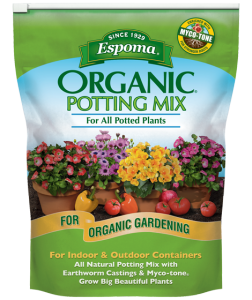

Houseplants are great for adding color, décor, texture or even a little bit of health to any space in your home. Sometimes the best place to put a houseplant isn’t the most ideal for the plant, but with these low light houseplants, they will thrive in even the darkest corners. Don’t forget, these plants can go anywhere indoors, like an office space that can use a little life.
Garden Answer’s Favorite Low-Light Plants
Peace Lily
Not many plants that tolerate low light areas have blooms, but this one does! It has interesting green or white flowers that are the same texture as the foliage, which is dark and glossy. The flowers bloom for long periods of time. Peace lilies can grow 18 to 36 inches tall and wide, depending on the container you have them in. Water every week or so, be sure not to overwater, and as a friendly reminder the foliage will droop if it needs more water.
Pothos
This houseplant thrives in places out of direct sunlight and is super low maintenance, so place them wherever you want to enjoy them. They can be planted in hanging baskets or on ledges to allow the foliage to drape over and trail down. Water every 10 to 14 days.
Sansevieria
Also known as a Mother-in-law’s tongue or a snake plant, this houseplant has striking foliage that grows upward. It is a very modern plant that comes in different shapes, sizes and colors, so it will truly work with any decor. It is very low maintenance — just keep an eye on the foliage for wilting and water about every two weeks when the soil is completely dry. In the winter, you may go a month between waterings. Add water away from the plant – never pour over the leaves.
Spider Plant
This is another interesting plant to add to any space. It is multigenerational, meaning it is easy to propagate and pass on to others (even kids and grandkids) to start their own. The name Spider Plant comes from the off shoots on the foliage. They look like little spiders hanging from a web. Pinch an off shoot (or spider) and plant it in a pot with fresh Espoma Potting Soil to start a new plant. Water once a week to keep them happy.
ZZ Plant
The dark green healthy foliage on this plant is worth noting, though it isn’t always that way. The foliage starts off bright green when it is freshly planted and will darken as time goes on. While other plants can get little burns from being indoors, the ZZ plant is hardy enough to withstand anything, even the darkest of corners. This is probably the toughest plant of this list.
Remember, low-light houseplants need time to absorb water, so allow them to dry out in between watering. The peace lily is the only exception, as they prefer it a bit moist. Use a damp cloth to wipe down the leaves every month or so. This will help keep your plants looking better as dust settles on them. Be sure to keep the cloth damp as they need humidity to survive too. In addition to the cloth, spray a mist over the foliage with distilled water to amp up the humidity around the plant.
Feed your houseplants regularly with Espoma’s Indoor! liquid plant food. It is an all-purpose houseplant food to help give them the nutrients they need. Lastly, be sure to check the roots every six months to see if you need to move your plants to a bigger pot.
Products:


